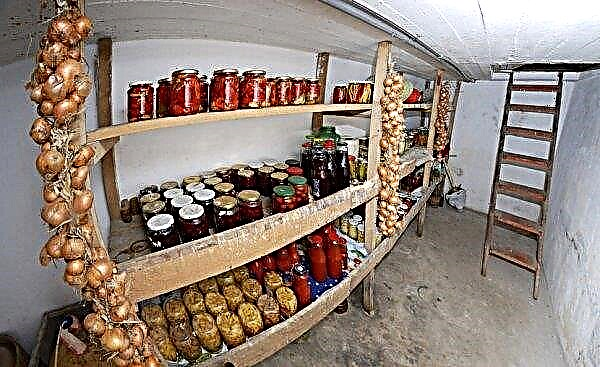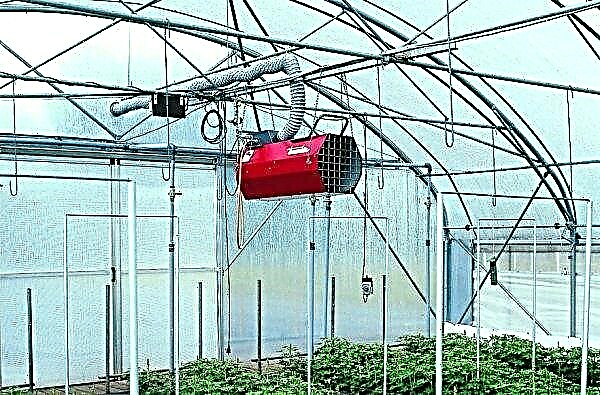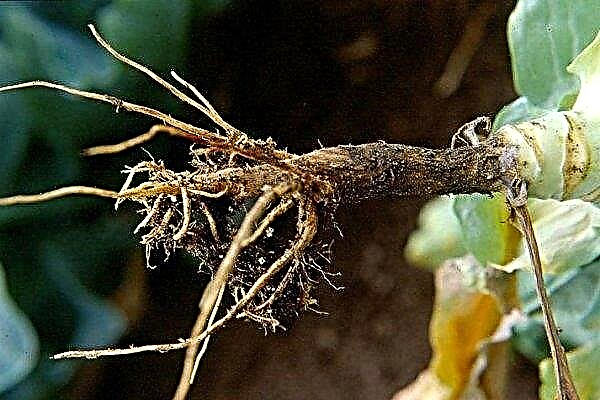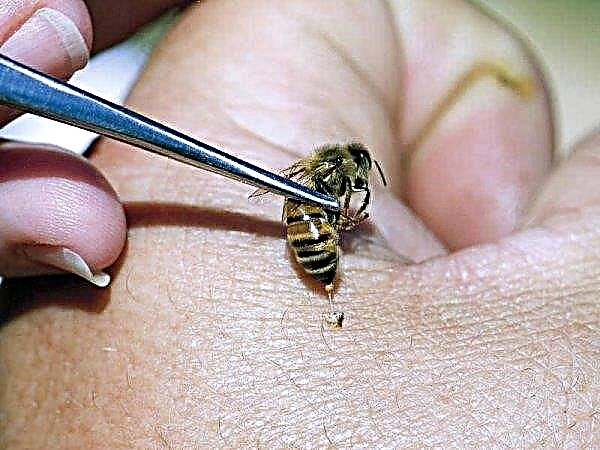Everyone who has grown pepper at least once knows how much harm the harmless small caterpillar brings to the plant. Holes on the leaves of the culture testify to its presence, and this is not the main damage: if measures are not taken in time, only streaks that once were stems and leaves can remain from your pepper. Read more about pests and methods of controlling them below.
What caterpillars can appear on pepper
Most often, pepper plantings are susceptible to attacks by scoop caterpillars. Their danger is that they gnaw at the bottom of plant stems, leaving them no chance to survive.
There are close to a hundred species of scoops, and many of them are omnivores, and it is almost impossible to exclude their appearance on your landings. Therefore, be careful, because it is quite difficult to detect a pest - it flies at night, and prefers to hide during the day.Important! Caterpillars of scoops can attack pepper twice a season: in spring (April-May), and in summer (July-September).
On your bell pepper you can find such varieties of scoops:
- Gardening. It belongs to the number of omnivorous pests, and in its menu more than 40 varieties of crops. Damage to plants is not caused by the butterfly itself, but by the larvae deposited by it, from which caterpillars quickly grow. The egg-laying period is June. It is not easy to notice them, because the moth makes masonry on the underside of the sheet, forming dense piles, 2-3 layers thick. You can recognize an adult caterpillar by pink-brown or greenish color. The variety is also indicated by white longitudinal stripes on the back, and yellowish on the sides. The head is painted pink-yellow. Initially, the caterpillars eat foliage cells, gradually biting into their tissue. Then they get to the fruits, eat them and pollute them with their secretions (excrement), which soon leads to rotting of pepper fruits. Garden scoops differ in their gluttony. The insidiousness of the pest is that it hibernates in the soil.

- Exclamation point. It is so named due to the fact that a moth clearly stands out in the form of an exclamation mark on the wings painted in brown-gray tones. The egg laying place is the back of the foliage, which grows above the soil. The "body" of the caterpillars is bare, painted in earthy gray, brown or dark green. White stripes or spots are clearly visible on the back. The initial food for the caterpillars is the upper parts of the pepper (tops, shoots). With age, pests migrate to the soil and feed on roots, sprouts and seeds of the crop. At night, scoops crawl out of the ground and gnaw plant stems.
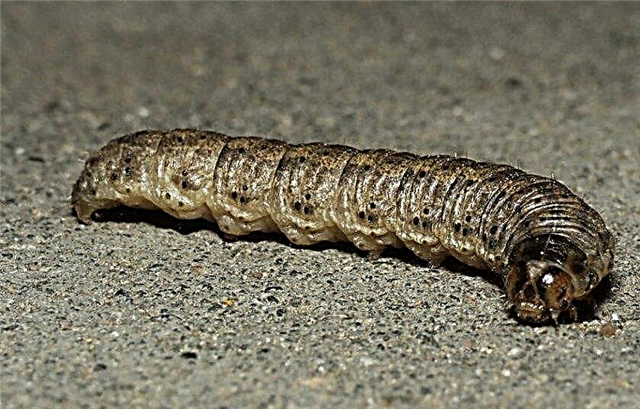
- Winter. The scoop got its name due to the fact that a fully formed caterpillar hibernates in the egg shell, which leaves only when the temperature in the spring is stable at + 8 ... + 10 ° С. A suitable feed for a newly hatched caterpillar is weeds. But, soon her taste preferences change, and she pounces on cultivated plants - she eats primarily peppers and tomatoes. The pest is dangerous because it is able to completely destroy the planting, because it gnaws the stem near the soil, or the roots. You can recognize dirty men by their earthy gray color with shiny olive shades. In winter, the caterpillar is able to dig into the ground by 30 cm.

- Cotton. Quite large (body length - 35–40 cm) and covered with small spikes. It can be painted in green, yellow and brown-red tones with a necessarily yellow head. Three bands are clearly distinguished on the body, crossing it along. On the chest shield is a marble pattern. Pest butterflies fly out only when it gets dark, but in the autumn they appear in the daytime. One female moth is capable of laying from 500 to 3000 eggs. Pests overwinter in the ground. Initially, they pounce on the leaves of pepper, then begin to absorb flowers, buds, fruit ovaries and the fruits themselves (penetrate inside from the stalk).
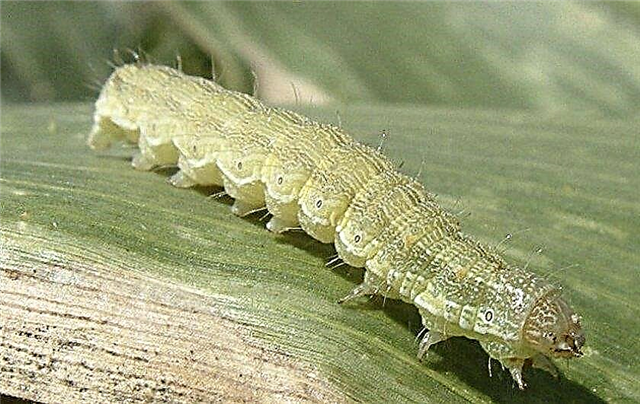
- Gamma scoop. A green or green-blue caterpillar, the back of which is marked with white longitudinal stripes, and the sides are yellow. A distinctive feature of butterflies is a peculiar golden Greek letter gamma on brown wings. The food of such a caterpillar is pepper foliage. From it there are only hanging veins.

- Tomato (karadrin). A brown-gray or green caterpillar, 25-30 cm long. The sides are marked by smooth longitudinal two-color lines: dark and yellow. Small spikes are clearly visible on the back. During the season, the female can lay from 300 to 1700 eggs. The main food of the pest is foliage, flowers, fruits of pepper and other nightshade. Bad guys develop throughout the season - from 2 to 4 broods.
Important! If you are not sure that the caterpillars attacked your pepper, then put a small container in the greenhouse with fermented kvass for the night. Insects will certainly feast on such a treat, and in the morning you will find them in kvass.
Reasons for the appearance
The appearance of caterpillars on your pepper can be triggered by the following factors:
- Acquisition of infected seedlings (pest eggs may be laid on their leaves).
- Use in the greenhouse of contaminated soil. Caterpillars winter in the ground, and can get into the greenhouse along with the substrate.
- Humid environments and prolonged rains are ideal weather for propagating dirty tricks. In a period of drought and under the influence of direct sunlight, the eggs of the scoop simply dry. Therefore, if you grow peppers in a greenhouse, make sure that the humidity is not high, and also do not overdo it with watering.
- Lack of food in neighboring areas. Caterpillars can simply crawl out of other areas if they run out of food. Moreover, such an insect is able to overcome long distances.

How to fight and how to process peppers
If you find uninvited guests at your site, you need to take immediate control measures, a slowdown can lead to loss of crop and death of the crop. How to deal with pests, read on.
Chemicals
Chemicals will help to quickly and efficiently eliminate the scoop. So, if the caterpillar just appeared on your site, it is recommended to spray the crops with “Agrovertin”, “Fitoverm”, “Lepidocide”. In the case of a large degree of damage, contact-intestinal insecticides Sherpom, Decis, Intavir, Confidor-Maxi, Aktar, Karate-Zeon will be appropriate.
Important! Strictly follow the dosages and processing rules specified in the instructions for insecticides. Do not allow funds to reach growing crops.
Folk remedies
If you are not a supporter of chemical pest control agents on pepper crops, or it is impossible to use these products, due to the fact that you need to harvest soon, you can turn to folk wisdom and get rid of insects using folk remedies. Against caterpillars it is effective to use:
Against caterpillars it is effective to use:
- Garlic tincture. For its preparation, it is necessary to grind 200 g of garlic cloves with a meat grinder or blender and insist them in 10 l of water for a day. Then spray the culture, pre-filtering the tool.
- Infusion of husks from onions. About 200 g of onion husks pour 10 liters of water and insist 3-4 days. Strain, sprinkle peppers.
- Caterpillars cannot tolerate tobacco. Therefore, tobacco tinctures are an effective way to combat them. To prepare the tincture, you need to take tobacco (tobacco dust, shag) and water in a ratio of 1/10. The product should stand for 2-3 days. Before use in the infusion, you need to add water in the proportions of 1 part tincture / 2 or 3 parts of water.
- Hot pepper broth. Such a tool is prepared by boiling 100 g of chopped hot pepper in 1 liter of water. The drug should boil for one hour. Then it is removed from the fire, cooled, poured into a glass container and insisted for 2 days. Do not spray with a concentrated preparation: 50 g of the decoction must be dissolved in 10 l of water. Only after this can we begin the procedure for processing pepper plants.
- Infusion of yarrow. For the preparation, the dry mass of the plant (800 g) is used, which is steamed in boiling water (30–40 minutes). After that, pure water is added to the tincture (so that the total amount is 10 l) and insisted for about 2 days. After the specified time, the product is filtered and sprayed with pepper plantings.
Important! There is no guarantee that after a single spray, the pests will disappear immediately. Experienced gardeners recommend repeating the procedure 3-4 times with an interval of 7-10 days.
Mechanically
Everyone who wonders what to do to get rid of the caterpillars on peppers as soon as possible can try to eliminate the pests mechanically.  The following measures can be taken:
The following measures can be taken:
- Set traps. Traps can be light with sticky tapes, they are effective in combating moths. You can also use pheromone traps. Pheromones for dirty tricks are fermented molasses, yeast or kvass, even fermented jam, fruit compote or juice, containers with which must be installed at a height of 20–25 cm above the soil: both moths and caterpillars will smell and fall into the trap.
- Inspection of the back of the leaves of pepper and the destruction of eggs scoops manually. The case is quite troublesome, but in this way you can reduce the population of pests that will soon be hatched.
- Manual caterpillar picking. It is difficult because in the daytime they are rarely seen.
- Elimination of weeds that provide butterflies to scoops with nectar: without nectar, adult moths will starve to death. In addition, weeds serve as additional egg laying sites.
Did you know? In the body of the caterpillar, there are nearly 4000 muscles, in the human body, for comparison, only 629 muscles.
Preventive measures
To prevent scoops from appearing on pepper is much easier than fighting them later. It is enough to observe some preventive measures, namely:
- comply with crop rotation rules;
- systematically weed plantings and remove weeds;
- systematically loosen the soil under plants and aisles;
- digging the soil deep in the fall, after the crop was harvested in order to detect and destroy the caterpillars and pupae that have already hidden in the ground for the winter;
- sprinkle the grooves of the sections with freshly slaked lime.
Check out the features of growing such varieties of pepper:
Useful Pepper Growing Tips
Bell pepper - the culture is quite whimsical and capricious, and requires strict adherence to the rules of cultivation. Experienced gardeners reveal some secrets to growing pepper:
Experienced gardeners reveal some secrets to growing pepper:
- You can not plant crops on the same site every year. It is necessary to maintain an interval of 4 years.
- Plant proven varieties, that is, those with which you consistently harvest a high crop. If you want to start growing a new variety, first plant several bushes for testing (5-6). Do not plant the entire plot with a variety that has not been grown before, because the plant may not like the conditions and you risk being left without a crop.
- Do not allow the soil to dry out, as this can lead to the death of a plant whose roots will suffer from a lack of moisture.
- Collect ripe fruits in a timely manner so that the plant has the strength to form new ones, and, accordingly, the amount of yield does not decrease.
- Do not overfeed pepper with nitrogen and nitrogen-containing fertilizers (manure, weed infusions). This can lead to a lack of budding.
- Keep track of humidity and air temperature in the greenhouse and outdoors. A humid environment, cold, and excessive heat can cause the plant to bloom, but ovaries will not form. In order to set fruits, it is necessary to sprinkle the culture with a solution of "Bud" or "Ovary". It is also necessary to ventilate the hotbeds in hot weather, reduce the amount of watering and heat the greenhouses during cooling.
- Feed your crop on time. The appearance of light spots, which soon decay on pepper fruits, indicates that the plant suffers from a lack of fertilizers, and more specifically calcium, potassium.
Did you know? Bell pepper contains much more vitamin C than citrus fruits.
As you can see, one of the main enemies of pepper and other types of nightshade is caterpillars, small creatures that can become a source of great harm. Therefore, if you suspect that such uninvited guests have settled on your site, immediately start fighting them so as not to lose precious time and have time to save both the plants themselves and the future crop.







